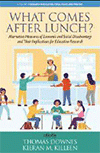
What Comes After Lunch?
Alternative Measures of Economic and Social Disadvantage and Their Implications for Education Research
Edited by:
Thomas Downes, Tufts University
Kieran M. Killeen, University of Vermont
A volume in the series: Research in Education Fiscal Policy and Practice. Editor(s): Kieran M. Killeen, University of Vermont. Thomas Downes, Tufts University.
Published 2024
Faced with the problem of how to measure the magnitude of economic disadvantage in the populations served by schools or districts, researchers addressing school finance topics have invariably turned to the fraction of students eligible for free- or reduced-lunches (FRPL). But the facile dependence on FRPL may be problematic. A large and growing literature in learning sciences and in the field of education itself has pivoted towards studies that explore the relationship between social/emotional health and the learning of children. The growing body of research on social/emotional health and learning (e.g. Gershoff, Aber, Raver, and Lennon, 2007) suggests that more refined measures of wealth, income and hardship more fully account for the effects of economic disadvantage than does FRPL. Historically, research in school finance has not utilized these refined measures but instead has depended on FRPL.
The Community Eligibility Provision (CEP), a recent change in how student eligibility for free lunch is determined, may have the unintended, and yet fortuitous, consequence that it will force school finance researchers to use more sophisticated measures of student hardship. The CEP makes it possible for schools serving low-income populations to classify all students as eligible for free- or reduced-price lunch. Koedel and Parsons (2021) argue that, while FRPL might have been a workable measure of student disadvantage prior to CEP, post-CEP the extent of a school’s or a district’s population that is disadvantaged is no longer measured accurately by FRPL. The CEP made accurate FRPL counts less critical for many schools and districts; post-pandemic legislation (Vock, 2023) in a number of states to make school meals free for all students in those states has increased the number of districts for which accurate counts are unimportant. Fazlul, Koedel, and Parsons (2023) go on to argue that, even prior to CEP, FRPL failed to provide an accurate measure of a school or district’s poverty. This new policy environment makes it imperative to explore alternatives to FRPL and the implications for school finance.
The book aims to provide a timely collection of new research on a measurement issue that is central to much research on K-12 education finance. The book is meant to serve scholars in education finance and policy who need a refined perspective on the context of schooling. The book is also meant to serve students and faculty from programs in public administration, public policy, community development and applied economics, education administration, educational leadership and policy studies who are studying content related to education policy, the economics of education, state and local public finance, and taxation. Some upper-level undergraduate students may also benefit from this resource.
ENDORSEMENTS:
"Fundamental to understanding the efficacy of many policies and interventions is having a clear picture of student poverty. The increasing uncertainty about the validity of student poverty measures due to changes in the free- and reduced-price lunch program in schools thus creates challenges for researchers and policymakers alike. This book offers insights into how to think about the ongoing utility of existing and new measures of students’ economic and social disadvantage, a topic that is both timely and important." — Dan Goldhaber, American Institutes for Research and University of Washington
"Understanding differences across schools in what they provide for students and, particularly the extent to which students living in poverty have access to differential opportunities, is essential for effective policy making. Yet, policy makers and education decision makers have not had accurate measures of their students’ economic resources, especially since changes in the subsidized lunch program. This important book offers needed suggestions for a range of new and reliable measures and related directions for research to improve education decision-making." — Susanna Loeb, Stanford University
CONTENTS
-
Paperback979-8-88730-562-2
Web price: $45.04 (Reg. 52.99)
-
Hardcover979-8-88730-563-9
Web price: $80.74 (Reg. 94.99)
- eBook979-8-88730-564-6

- EDU038000 - EDUCATION: Student Life & Student Affairs
- EDU060020 - EDUCATION: SCHOOLS: Types - General
- SOC050000 - SOCIAL SCIENCE: Social Classes
-
 American Higher Education
Contemporary Perspectives on Policy and Practice
American Higher Education
Contemporary Perspectives on Policy and Practice
-
 Fiscal Policy in Urban Education
Fiscal Policy in Urban Education
-
 High Stakes Accountability
Implications for Resources and Capacity
High Stakes Accountability
Implications for Resources and Capacity
-
 Recent Advancements in Education Finance and Policy
Recent Advancements in Education Finance and Policy
-
 Saving America's School Infrastructure
Saving America's School Infrastructure
-
 Small, Numerous, and Isolated
Contemporary Issues in Rural Education Finance
Small, Numerous, and Isolated
Contemporary Issues in Rural Education Finance
-
 Special Education During the Pandemic
Considerations for Change in Practice
Special Education During the Pandemic
Considerations for Change in Practice

